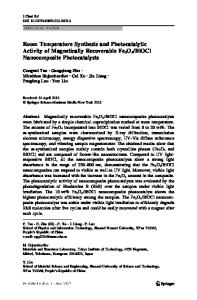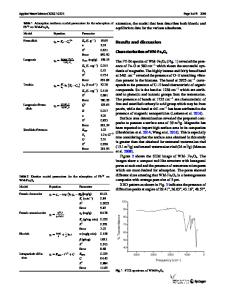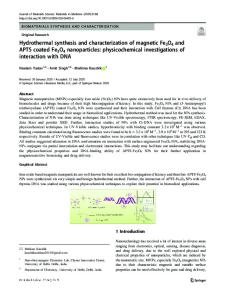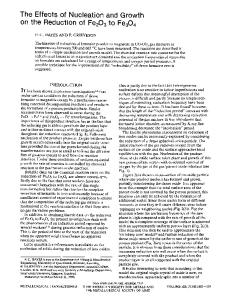Fe 3 O 4 Nanomachine Manipulated Magnetically
- PDF / 107,401 Bytes
- 1 Pages / 576 x 783 pts Page_size
- 42 Downloads / 368 Views
Fe3O4 Nanomachine Manipulated Magnetically Ever since 1959, when physicist Richard Feynman famously declared “there’s plenty of room at the bottom,” researchers have worked feverishly to make functional materials smaller and smaller. Of interest to many in this field are micro- and nanomachines that have the ability to manipulate other small materials. Instruments such as these are helping researchers to develop an understanding of mechanical motion on the nanoscale. A team of researchers from Jilin University in China led by H.-B. Sun recently developed a new magnetically controlled micro-spring using two-photon polymerization that may help improve the understanding of nanomechanics. As described in the March 1 issue of
Rewritable Conductive Channels Observed in Multiferroic BiFeO3 An international team of researchers led by R. Ramesh (University of California at Berkeley) has observed conductivity at ferroelectric domain walls in BiFeO3, presenting a new degree of functionality in the popular multiferroic and the possibility of rewritable nanoscale devices. The research team, including J. Seidel and L.W. Martin (UC-Berkeley; Lawrence Berkeley National Laboratory), Y.-H. Chu (UC-Berkeley; LBNL; National Chiao Tung University in Taiwan), A. Rother (Technische Universität Dresden, Germany), P. Maksymovych (Oak Ridge National Laboratory), S. Gemming (Forschungszentrum DresdenRossendorf), G. Catalan (University of Cambridge, UK), N.A. Spaldin (University of California at Santa Barbara), and their colleagues, report their findings in the March 2009 issue of Nature Materials (DOI: 10.1038/nmat2373; p. 229). The research team grew BiFeO3 (BFO) films by laser-molecular-beam epitaxy on SrTiO3 substrates with bottom electrodes of SrRuO 3 . By writing ferroelectric domain patterns with piezo response force microscopy (PFM), the researchers created three types of domain walls: 71°, 109°, and 180°, where the angle refers to the change in orientation of the polar moment across the domain wall. They measured conductivity across the films using conductive atomic force microscopy (c-AFM) and found, to their surprise, that the 109° and 180° walls conduct electricity, displaying Schottky-like response when probed with the scanning probe tip, in stark contrast to the resistive behavior measured in the rest of the film.
Optics Letters (DOI:10.1364/OL.34.000581; p. 581), the researchers prepared ironoxide–loaded springs using two-photon polymerization. The springs, formed from a photoresist consisting initially of methyl methacrylate as monomer, pentaerythritol triacrylate as the cross-linker, and a small amount of photoinitiator and photosensitizer, were loaded with 10 nm superparamagnetic Fe 3O 4 nanocrystals. The re searchers determined loading of iron oxide nanocrystals by thermogravimetric analysis to be 2.4%. Using a computercontrolled Ti-sapphire laser (790 nm), the resin was cured with tightly focused femtosecond laser pulses. Scattering from the nanoparticles limited the overall resolution of the polymerization technique. In
Data Loading...











